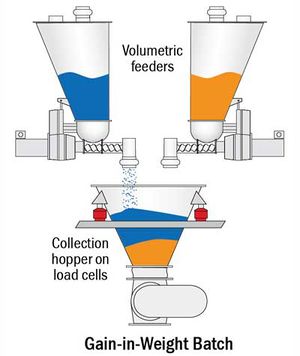Difference between revisions of "Gain in Weight Dosing Systems"
| (One intermediate revision by one other user not shown) | |||
| Line 1: | Line 1: | ||
[[Category:Dosing]]{{Knoppen}} | [[Category:Dosing]]{{Knoppen}} | ||
[[File:Gain in Weight Dosing Systems.jpg|thumb|right|Gain in Weight Dosing Systems]] | |||
'''Gain in Weight Dosing Systems''' are widely used to deliver bulk solids into a batch process. In a typical [[Batch Feeders|batch feeding system]] individual [[Volumetric Feeders|volumetric feeders]], each one dedicated to a single raw material or active ingredient, are employed. Each [[Feeders|feeder]] delivers its material in sequence into a central collection [[Hoppers|hopper]], mounted on a [[Feeders Scales|scale]] or [[Loadload Cells|load cells]]. | |||
The weight of the receiving [[Vessels|vessel]] is monitored continuously as each ingredient is added in succession. Weight measurements are compared to the setpoint for each ingredient. | |||
When the required weight of an ingredient approaches its setpoint, the volumetric feeder goes into drible mode so to insure the feeder doesn't overshoot its target. When setpoint is reached, discharge from that feeder is stopped, and the next feeder is started. | |||
Once all the batch ingredients have been fed into the central gain-in-weight vessel, they are discharged into a mixer or blending system, or delivered directly to the next downstream step in the process. | |||
Gain-in-weight batching systems using volumetric feeders can typically achieve accuracies of +/- 0.5% of the full scale capacity. | |||
When minor or micro ingredients must be added with greater precision, loss-in-weight feeders may be employed to feed these critical ingredients. In these hybrid batching systems, the loss-in-weight batch feeders can deliver accuracies of +/- 0.1 - 0.5% of batch weight setpoint. | |||
==Components== | |||
* volumetric feeder, | |||
*[[Screw Feeders]] | |||
*[[Twin Screw Feeders|twin screw]] | |||
*Bulk Solids Pump (BSP) | |||
*[[PID Controllers]] | |||
Latest revision as of 21:03, 31 March 2013
Gain in Weight Dosing Systems are widely used to deliver bulk solids into a batch process. In a typical batch feeding system individual volumetric feeders, each one dedicated to a single raw material or active ingredient, are employed. Each feeder delivers its material in sequence into a central collection hopper, mounted on a scale or load cells.
The weight of the receiving vessel is monitored continuously as each ingredient is added in succession. Weight measurements are compared to the setpoint for each ingredient.
When the required weight of an ingredient approaches its setpoint, the volumetric feeder goes into drible mode so to insure the feeder doesn't overshoot its target. When setpoint is reached, discharge from that feeder is stopped, and the next feeder is started.
Once all the batch ingredients have been fed into the central gain-in-weight vessel, they are discharged into a mixer or blending system, or delivered directly to the next downstream step in the process.
Gain-in-weight batching systems using volumetric feeders can typically achieve accuracies of +/- 0.5% of the full scale capacity. When minor or micro ingredients must be added with greater precision, loss-in-weight feeders may be employed to feed these critical ingredients. In these hybrid batching systems, the loss-in-weight batch feeders can deliver accuracies of +/- 0.1 - 0.5% of batch weight setpoint.
Components
- volumetric feeder,
- Screw Feeders
- twin screw
- Bulk Solids Pump (BSP)
- PID Controllers
